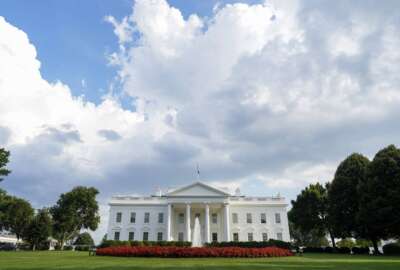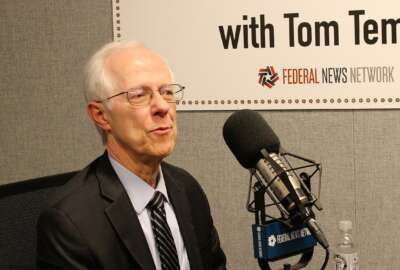Hubbard Radio Washington DC, LLC. All rights reserved. This website is not intended for users located within the European Economic Area.
How Congress lost its tech groove at the corner of CitiBank and a fruit basket
Congress, as an institution, doesn't appear to have the technological skills and knowledge to ask the right questions when it comes to increasingly complex agen...
The botched rollout of HealthCare.gov cast a harsh light on large-scale federal IT projects and the arcane, often incomprehensible, procurement process that powers them.
But in heated congressional hearings examining the site’s malfunctions over the past month, lawmakers appeared more expert in expressing outrage than in rooting out the site’s actual technological failings.
It was like “people who can’t read doing literary criticism,” said Clay Johnson, a former Presidential Innovation Fellow and the CEO of the nonprofit Department of Better Technology, in describing the hearings in a recent MSNBC interview.
The issue isn’t that there weren’t major problems with the HealthCare.gov site. It’s that, in many cases, Congress, as an institution, doesn’t appear to have the technological skills and knowledge to ask the right questions when it comes to increasingly complex agency IT programs, experts and observers told Federal News Radio as part of the special report, A New Era in Technology.
“The incapacitation of Congress to handle complex problems … with data is a huge challenge for all of us,” said Lorelei Kelly, a research fellow with the New America Foundation, who has written extensively about technology and congressional decisionmaking.
Tech illiterates?
An exclusive Federal News Radio survey of nearly 1,000 federal employees and contractors, revealed a clear lack of confidence in Congress’ ability to legislate and oversee federal technology efforts. “These are technological illiterates,” one respondent wrote. “For the kind of legislation needed in these high-tech areas, Congress may as well be debating the logistics of brain surgery,” wrote another.
But it wasn’t always so. Fewer than 20 years ago, Congress had a thriving 200-person technology think tank at its disposal, tasked with conducting research and analysis on pressing science and technology issues. Over the years, the Office of Technology Assessment issued reports on everything from acid rain and AIDS to virtual-reality and wireless technologies — influencing both the debate and legislation coming out of Capitol Hill.
Amid a wave of budget-cutting in the mid-1990s, however, Congress voted to defund and dismantle the agency.
There have been numerous attempts over the past 18 years to resurrect the OTA. Rep. Rush Holt (D-N.J.), one of only two physicists currently serving in Congress, has been an ardent supporter of reviving the agency.
“OTA had a combination of relevance and intelligibility and authoritative expertise that has been unmatched,” Holt told Federal News Radio.
Proponents of restoring the OTA cite the rapid pace of technological change since the agency was eliminated: the rise of the Internet, smartphones, social networking, the commercialization of GPS technologies and fuel-efficient hybrid cars.
“More and more of the problems facing government are highly technical,” said Tara O’Toole, a former OTA staffer who worked for the agency in the late 1980s and early 1990s. She later joined the Energy Department in the Clinton administration and became the top technology official in the Homeland Security Department under President Barack Obama.
“Pick any agency — and it doesn’t have to be NASA,” she said. “How bad is the environment? … What about our weapons systems? What really matters? What can we afford to do without? How can we create big, integrated IT systems? I mean, DHS has failed three times to create an integrated financial system — as have most other agencies, by the way. What’s up with that? You could go on and on.”
A body of Congress
Faced with similarly troubling technological questions — nuclear weapons testing, pesticide use and supersonic transport, among others — Congress authorized the creation of the Office of Technology Assessment in 1972. The new agency was to secure “competent, unbiased information concerning the physical, biological, economic, social, and political effects” of new and emerging technologies, according to the legislation that created the office.
“The idea was to look at technologies that were being introduced or expanded and to try to look at their effects on society in an analytical way and, then, present that to the committees of Congress who were considering legislation on those things,” said Peter Johnson, an OTA veteran who joined the agency in 1974 and stayed until Congress closed its doors in 1995.
Former staffers say what set OTA apart from the National Academies, which also conduct public-interest scientific research, and other organizations was its close relationship with Congress and unique staffing structure.
“OTA was not an outside agency to be called upon by Congress from time to time, but a body of Congress,” John “Jack” Gibbons told Federal News Radio. A well-respected scientist and Energy Department official, Gibbons led the agency from 1979 until 1993, when he left to become President Bill Clinton’s top science adviser.
The Technology Assessment Board, split evenly between House and Senate lawmakers of both parties, oversaw the agency’s work and approved research requests. While throughout its lifetime, OTA remained the smallest of the Capitol Hill agencies, it also frequently brought in outside experts — as many as 2,000 in some years — to work on individual reports. The average report took about 12-14 months to complete. In its heyday, the agency began work on as many as 15-20 new projects a year.
Far-reaching reports
The goal wasn’t to make recommendations but to provide lawmakers with a number of policy options along with the cost, technical feasibility and, even, societal impacts of particular technologies.
The best evidence that such an organization is still needed today is to look at the work OTA actually did, Holt said.
“The reports on all sorts of subjects from oil clean-up to policy for Alzheimer’s disease are still relevant. … The work that was done was of a quality that holds up over time,” he said. “And, the work is, after all these years, some of the best work on these subjects.”
All of the agency’s 750 reports have been digitally archived on Princeton University’s website. Many are notably prescient.
For example, in 1982 — nearly a decade before the term “email” would enter the popular lexicon — OTA cautioned that the potential proliferation of electronic message systems (EMS) would have profound consequences for the U.S. Postal Service.
“Changes are taking place so fast in the so-called ‘communications revolution’ that by the time USPS actually experienced significant reductions in conventional mail volume, most opportunities for participation in EMS would have passed and it would be much more difficult to adjust,” OTA researchers concluded.
A 1984 report casting doubt on President Ronald Reagan’s pet project, the Strategic Defense Initiative, known as “Star Wars,” thrust the agency into controversial terrain.
An MIT physicist named Ashton Carter — now, incidentally, the deputy director of the Defense Department — concluded in the report that the successful missile-defense system envisioned by Reagan’s Pentagon was ”so remote that it should not serve as the basis of public expectation or national policy.”
Despite the flap, by the late 1980s OTA had emerged as a “dispassionate, nonpartisan player” in congressional decisionmaking as a 1988 Associated Press report put it.
The small agency carried an outsized influence.
“It was replicated around the world,” said Kelly, the New America Foundation researcher. “It was the premier scientific advising body for a legislature in the world. And people came from all over to find out about it and do it in their own countries. And then we wiped it out.”
OTA’s demise
By the mid-1990s, the office — which by that time employed about 200 full-time staff members and drew an annual budget of $22 million — was vulnerable.
Buoyed by the Gingrich revolution, a wave of new Republican lawmakers came to Washington pledging to cut waste and shrink the size of government.
OTA was an easy target for budget-cutting lawmakers.
“It was a cut of convenience,” said Peter Blair, a former assistant director at OTA, who’s now the executive director of the Division on Engineering and Physical Sciences at the National Academy of Sciences.
At the time, OTA’s budget constituted less than 1 percent of the entire legislative branch budget.
“But you could make that cut and claim that you cut an entire agency from the U.S. Congress,” Blair said.
Blair led the “close-out team” at OTA, responsible for clearing out the agency’s offices in a brick colonial building at 600 Pennsylvania Ave., S.E., a few blocks from the Capitol. The building now houses a CitiBank and a store that sells fruit baskets.
During the legislative wrangling over defunding the agency, lawmakers said other agencies, such as the Congressional Research Service or the Government Accountability Office, could pick up the slack.
But proponents of the agency say — because of the unique nature of OTA and the constraints that other research agencies currently face — OTA’s absence is still felt.
“I don’t think anything that’s out there now is even close to filling the gap that OTA left,” Blair said.
What’s filled the gap?
Congress has attempted smaller-bore fixes to shore up gaps in its technical expertise since the agency’s demise.
In 2001, lawmakers directed GAO — then still known as the General Accounting Office — to conduct technology assessments as part of a pilot program. Between 2002 and 2006, the agency published a handful of reports before the technology-assessment function was permanently established within GAO in a fiscal 2008 funding bill.
Tim Persons, GAO’s chief scientist, said GAO modeled its effort on the original OTA effort, using the 1972 legislation that authorized OTA as the jumping-off point to define its own mission.
“Studying the history was important,” Persons said. “It was to go back and determine what did OTA do well?”
However, GAO’s team, run out of its Center for Science, Technology and Engineering, has only a tiny fraction of the staffing power of the OTA — just five dedicated full-time employees out of a total GAO staff of about 2,800.
Each report typically takes about 12 to 14 months to complete.
“We, of course, would like to get that down by doing more of them,” Persons said. “We’re at a phase of what I would call — if you’re familiar with the Department of Defense phrase — LRIP, and it stands for ‘low rate of initial production.’ So, we do these once in a while — we’re talking about maybe one or two a year.”
One of the problems is that GAO, itself, has faced budget pressures in recent years.
“Even before sequestration, there was the idea of finding and trimming budgets so we, GAO, are at a low level in terms of staff resources that we haven’t seen since 1935,” Persons said.
OTA reboot?
When Congress voted to defund the OTA, it didn’t actually override the legislation that created the agency, it only cut the purse strings that kept it operating.
But that doesn’t appear to have made reviving the agency any easier.
Holt’s legislative attempts to resurrect the OTA have revolved around reappropriating funds to get the agency back to work. However, the last attempt to do just that in 2011, providing just $2.5 million in start-up funding to reopen the agency, ultimately fell short.
The current budget squeeze played a role in that defeat, Holt said.
“Congress is so proud to go home and say we cut our expenses, never mind that we operate in a less informed way, that it’s hard to get them to agree to appropriate the funds for even something as worthwhile as the OTA,” he said.
Nevertheless, there’s been an uptick in interest in reviving the agency.
From his perch at the National Academy of Sciences, Blair has written a book, just published in September, examining the impact of the OTA, including options for how it could be revived and adapted for today.
“One big change would be to find ways to appeal to broader rank and file in the House and Senate,” Blair said. OTA only started work at the behest of chairmen and ranking members of committees, which served to isolate the agency.
“What it ended up doing was narrowing the political constituency for the agency, which, in the end, probably contributed to its demise,” Blair said, “in that you had only the leadership in the committees trying to protect it and the rank-and-file, which had just turned over dramatically in the 104th Congress, had no real understanding or nothing really vested in the OTA.”
A 2010 report for the The Woodrow Wilson International Center for Scholars written by Richard Sclove, the founder of the Loka Institute, a nonprofit seeking to increase citizen input in science policy, called for even broader changes to a potential OTA reboot.
“Proponents have generally taken it for granted that the former OTA established an unsurpassable gold standard for conducting [technology assessments] on behalf of Congress and the nation,” he wrote. But Sclove said a new technology-advisory body like the OTA would need to do more to take into account the input of everyday citizens and not just rely on expert analysis.
Holt agreed that improvements could be made to the OTA model, but said the important thing is first to get it back in business.
“We know that the OTA worked,” he said. “I’m not saying it couldn’t be improved on, but we don’t need to reinvent it anew. I’d say, just fund what we’ve got on the books and then talk about some modifications to it.”
MORE FROM THE SPECIAL REPORT: A NEW ERA IN TECHNOLOGY:
Demand for data-driven models supplies agencies with decision making power
Major reforms needed to effectively manage federal IT
Copyright © 2024 Federal News Network. All rights reserved. This website is not intended for users located within the European Economic Area.




